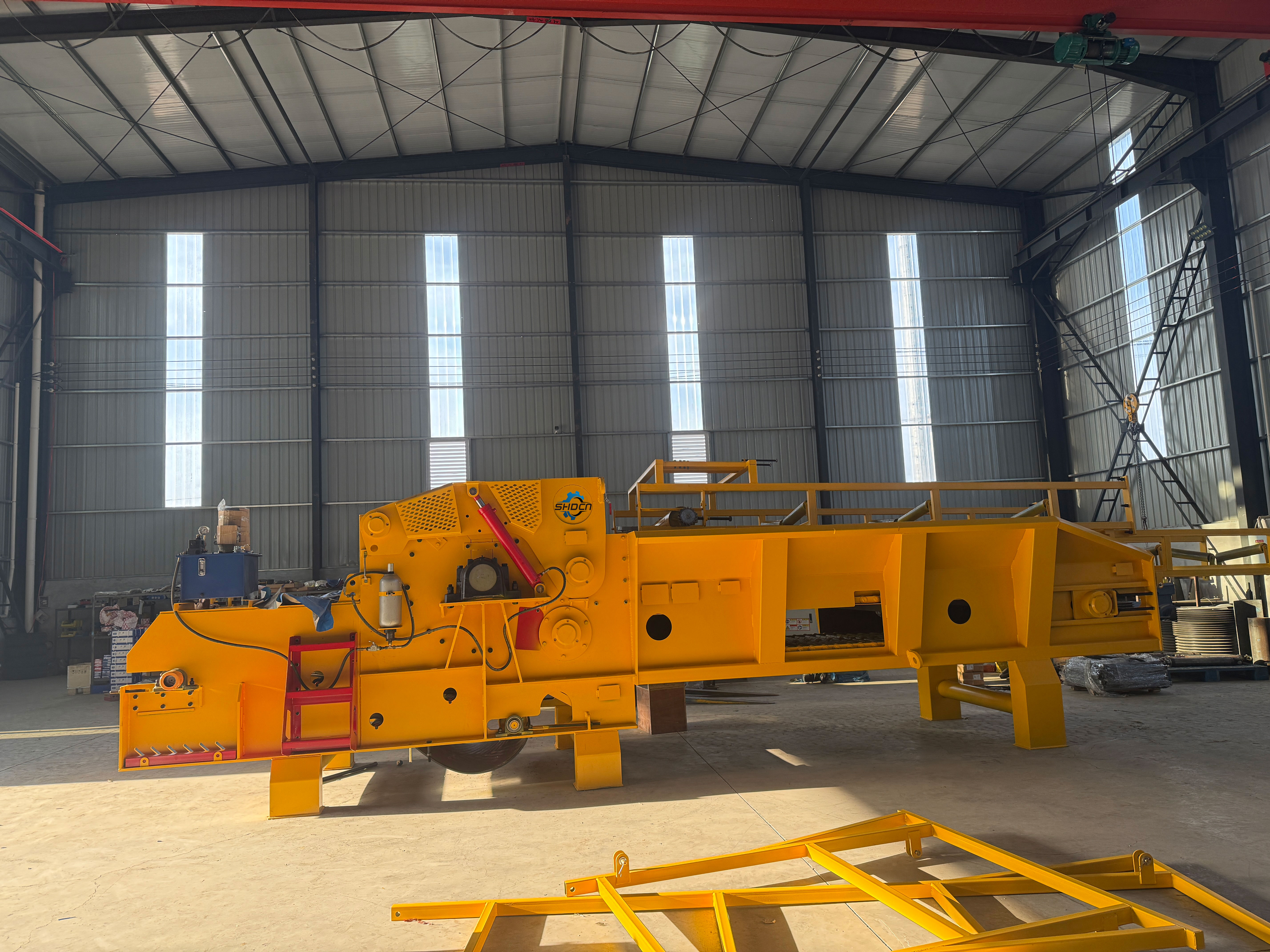ציוד מגן אישי חיוני להפעלת משגרי עצים
דרישות להגנה על הראש וביגוד עם ראות גבוהה
על המפעילים ללבוש כובעי בטיחות מאושרים על ידי ANSI לשם הגנה מפני נפילת חפצים ופציעות ראש במהלך שימוש במשגרי עצים. ביגוד עם ראות גבוהה, כגוןベストים עם סרטים רטרו-רפלקטיביים, מבטיח נראות בתנאי אור לקויים או בשטחי עבודה צפופים. אמצעים אלו עומדים בדרישות התעשייה הכללית של OSHA לגבי ציוד מגן אישי בסביבות מסוכנות.
הגנה על השמיעה והעיניים מפני רעש ורסיסים מעופפים
מכסחת עצים יכולה להיות רועשת מאוד, לפעמים מעל 90 דציבלים, שזה פחות או יותר שווה ערך לעמידה ליד מכסחת דשא. מסיבה זו, עובדים זקוקים לאטמי אוזניים איכותיים החוסמים לפחות 25 דציבלים של רעש. בעת הפעלת מכונות אלה, יש ללבוש משקפי מגן עמידים בפני פגיעות או אפילו טוב יותר, מגני פנים מלאים, כל הזמן. שבבי עץ עפים לכל מקום במהלך הפעולה ויכולים לנוע מהר יותר מ-80 קמ"ש, על פי מספר מחקרים אחרונים (דו"ח מכון פונמון משנה שעברה). גם המספרים תומכים בכך. לאנשים שלובשים גם הגנה על השמיעה וגם מגן עיניים נאות יש סיכוי נמוך בכ-63 אחוז להיפגע בהשוואה לאלו שמגנים רק על חלק אחד בגופם. זה הגיוני באמת כשחושבים על מה קורה אם משהו משתבש בזמן הפעלת ציוד כה חזק.
בחירת כפפות, נעליים וביגוד מגן מתאים
- מיטפחים : כפפות עמידות לחתך מעור או עם ריפוד קברלאר וכפות יד מחוזקות משפרות את האחיזה ומحمות מפני חבלות.
- לבישת רגלים : מכנסיים וjakets הדוקים, עמידים tears מפחיתים את הסיכון להסתבכות; יש להימנע מבדים רופפים שיכולים להיתקע במכוניות.
- לבוש : מגפי אצבע פלדה עם כפות ניגרשות מספקים יציבות על פני שטח לא אחיד ומגנים על הרגליים מפני מכונות מסתובבות.
בחירת ציוד הגנה אישי (PPE) מתאימה מפחיתה פגיעות במקום העבודה ב 47%ומסייעת בציות לתקנות הבטיחות של ANSI Z133-2017 בתחום ההנדסה העץ.
בדיקת תפעול מקדים ושימור של מפרק העצים
בחינה של מפרק העצים למציאת סימני שחיקה, דליפות או תקלות מכניות
התחל כל משמרת עם בדיקה של 10 נקודות חשובות כולל להבים, מערכות הידראוליות וחגורות הנעה. מאפיינים מרכזיים כוללים:
- להבים cracked , שמפחיתים את יעילות החיתוך עד 40% (מכון הבטיחות לעיבוד עץ, 2023)
- דליפות נוזל הידראולי של יותר מ-10 טיפות לדקה
- แบรגים משולשים שגרמו לנדנוד של יותר מ-3 מ"מ בחלקים מסתובבים
בשנת 2022, חקירת OSHA גלתה ש-63% מתקריות המ_CHIPPER_ נבעו מפגמים מכניים שלא זוהו במהלך בדיקות טרום שימוש
אימות תקינות הגדרת המכונה ופונקציית כיבוי החירום
בדקו את כל הנעולים הבטיחותיים ואת מערכות הבלימה הריאקטיביות לפני הפעלה. ודאו:
- מגני תא הקציצה מקטינים פגיעות ידיים ב-91%
- כפתורי עצירה דחופה עוצרים את הפעילות בתוך פחות משנייה אחת
- מסנני מנהור הפליטה עוזרים לצמצם סיכוני קליעים
על המפעילים לבדוק מגנים אלו מדי יום לפי פרוטוקול בדיקת כיבוי ANSI Z133-2017
ודאו שהתקני הבטיחות פעילים לפני ההדלקה
| תכונה | קריטריונים של עברה/כשל | שיטת בדיקה |
|---|---|---|
| מערכת בלמים של להט | עצירה מלאה תוך 2 שניות | חסימה מדומה עם גוש בדיקה |
| חיישן עומס יתר | הפסקת פעילות ב-115% מהתפוקה הנומינלית | הגברת מהירות הזנה הדרגתית |
| מפסק תרמי | הפעלה מתחת ל-200°ף (93°מ) | סריקת מד חום תת-אדום |
יישום נהלי נעילה/תיוג (LOTO) נכונים במהלך תחזוקה מפחית פגיעות הסתבכות ב-78% (NIOSH, 2023).
נהלי פעולה בטוחים במהלך שימוש במטחנת עצי
שמירה על תודעה של מצב וניהול סיכונים במקום העבודה
לפני שנעילה כל מכונה, הסתכל טובות סביב מקום העבודה. בדוק אם יש חפצים שעלולים לגרום לאנשים ליפול, צפה באם יש משהו תלוי מעל שעשוי להיסדק, והיזהר מפני אדמה רכה או לא יציבה מתחתית הרגל. מומלץ מאוד שיהיה אדם עם ידע מקצועי עומד בסביבה כ/watcher/, במיוחד כשעובדים עם ענפים גדולים או קרוב לדרכי גישה תלולות שבהן החזיה מוגבלת. שמור על נתיבי מעבר נקיים מכל זבל וחפצים מיותרים בכל מקום שבו עובדים נעים, והצב סרט צבעוני בהיר סביב אזורי ההזנה של המכונות כדי שאיש לא יכנס במקרה לאזורים מסוכנים.
שמירה על מרחק בטיחות בין קהל לצוות במהלך הפעלה
הקים שטח ביטחון של 25 רגל סביב המנפח באמצעות מחסומים פיזיים או שלטי אזהרה. מעל 60% מפצועי צופים מתרחשים כאשר אנשים לא מורשים נכנסים לאזורים פעילים (דוחות תאונות OSHA). התאם את הליכי כיבוי ברורה ואכוף ביקורת גישה מחמירה במהלך הפעלה.
הימנע מהזנה יתר ומצב רמות הזנה מבוקרות
בעת הכניסה של ענפים למכונה, יש תמיד להתחיל מקצה הגזע ולחזיק את הידיים הרחק מאזור הכניסה לפחות ב-18 אינץ'. מוטות דחיפה הם חיוניים כאן. ספרון הבטיחות של OSHA למטחנים/מגרסים מדגיש נקודה זו בצורה חזקה למדי. אם אנו מתמודדים עם חומר שרוחבו עולה על 4 אינץ', העניינים נעשים קצת יותר מורכבים. יש להאט למהירות של כ-6 עד 10 אינץ' לדקה בעת ההאכלה. הקפיצה על שלב זה היא מתכון לאסון, שכן עיור ציוד גורם לכשלים מכניים בשליש מהתקלות במכונות לטיפול בעצים, לפי דוחות תעשייתיים. קחו את הזמן והניחו למכונה לבצע את עבודתה כראוי.
טפל בסכיני רסיסים ובסיכונים סביבתיים בצורה יעילה
יש להכניס צינורות פריקה בזווית כלפי מטה אל אזורי איסוף סגורים ולקבוע בגדים רפויים כדי למנוע הסתבכות. בעת עיבוד צמחייה יבשה, יש להפחית את סל"ד המנוע ב-15-20% כדי למזער חלקיקים הנישאים באוויר. עובדים החשופים לפסולת מעופפת צריכים ללבוש מגני פנים מלאים המאושרים לתקני ANSI Z87.1.
תגובה
תגובה לסתימות ותקלות ללא סיכון
הפסקת פעולת ההarusר של העצים לפני כל התערבות
לפני שתשיגו לתקן תקלות של חסימה, ודאו שכל המערכות כבויות לחלוטין – המנוע כבוי, להטאות נייחות וכל מקורות החשמל מנוטרלים. לפי נתוני הבטיחות העדכניים של OSHA משנת 2023, כבערך שבע מתוך עשר פגיעות בהילככות מתרחשות כאשר עובדים מנסים לנקות חסימות ללא עקירת הליכי כיבוי מתאימים. אל תשכחו לבדוק שהאנרגיה נחסמה כראוי – בדקו את שחרור הלחץ ההידראולי וודאו שהלהטאות נעולות במקומן. חשוב מאוד לעבור הדרכה לזיהוי סימני אזהרה מוקדמים. צוותים שלומדים לזהות תופעות כמו רעדים מוזרים או צלילים חריגים במכונות נוטים להתערב לפני שהבעיות מתדרדרות, ובכך מקטינים את הצורך בתיקונים דחופים כמעט בחצי, על פי מחקרים של ענף התעשייה. מניעה משתלמת באמת לאורך זמן.
שימוש בכלים מתאימים—ולא בידיים—לניקוז תקלות
השתמשו במוטות חישול מפלדה, מוטות או כלים מיוחדים להסרת חסימות כדי לשמור על מרחק בטיחות מתא החיתוך. מחקר של NIOSH משנת 2022 הראה שפצעי חתכה ירדו ב-82% כשמוסדות החליפו הסרה ידנית בכללים המשתמשים בכלים. כללים מרכזיים כוללים:
- השתמשו בכלים עם ידיות לא מוליכות קרוב למקורות חשמל
- אסור להיתן מעל פתחי הכניסה במהלך הסרה
- בדקו את הכלים למציאת נזק לפני כל שימוש
הקמת הליכי נעילה/תגיות (LOTO) לצורך ביטחון
הליכי LOTO מונעים הפעלה אקראית במהלך תחזוקה, ועוזרים למנוע כ- 120 פגיעות קטלניות מדי שנה (OSHA). שלבים חיוניים כוללים:
- הפרדת מקורות אנרגיה : ניתוק סוללות, צינורות דלק או כבלים חשמל
- מנעולים אישיים : כל עובד מניח את המנעול שלו על לוח הבקרה
- אימות : בדיקת הפעלה של המטחנה לאחר הנעתה כדי לאשר חוסר מתח
חברות ש tiến conducting ביקורות חודשיות של LOTO הפחיתו את הזמן המתוכנן ללא ייצור ב-31% בהשוואה לאלה שביצעו ביקורות לא סדירות (ניתוח 2023).
התאמת התקנות של OSHA ו-ANSI לבטיחות מטחנות עצי
תקנות OSHA להטלות טיפול בעצים ואכיפה
עדיין אין ל-OSHA תקן ספציפי למגרסים עציים, ולכן אנשים שמפעילים מכונות אלו חייבים לעקוב אחר התקנים התעשייתיים הכלליים המתוארים ב-29 CFR 1910. זה אומר שהצורך להתייחס בתשומת לב רבה לסעיף המשנה I, שמכסה ציוד מגן אישי, ולסעיף המשנה O, שדן בדרישות של חסימת מכונות. יש לספק הגנה מתאימה לחלקיקים הסובבים במכונות אלו, ועובדים חייבים בהחלט ללבוש כפפות עבות עמידות לחתיכה בעת הטיפול בהן. אי עמידה בהנחיות הבטיחות איננה רק מסוכנת – חברות עלולות להיתקל בעונשים חמורים אם יימצאו חסרות. מדובר בעבירות שעשויות להגיע לכ-15,000 דולר אמריקאי ויותר עבור כל הפרה, לפי נתוני OSHA האחרונים משנת שעברה.
תקני ANSI Z133-2017 לבטיחות בעבודות עצים
המכון הלאומי האמריקאי לתקנים (ANSI) Z133-2017 מספק הנחיות ספציפיות לפעולת מטחנות עץ, הכוללות:
- מרווחי תחזוקה מינימליים למניעת כשלים מכניים
- דרישות לטווח זריקת חומרים (25 רגל מהצופים)
- אישור שנתי למשתמש
עמידה בתקנים אלה מפחיתה את הסיכונים להסתבכות ולקליעים ב-63% בהשוואה לפרקטיקות לא מפוקחות (מועצת הבטיחות לגידול עצים, 2022).
חובות מעסיק ועובד בהדרכת בטיחות והامتثال
על המעסיקים לספק הדרכה בהתאם ל-OSHA הכוללת סדרי הפעלה/הפסקה ותרגולים למקרה של חירום. על העובדים להפגין ידע בתהליכי נעילה/תגית לפני הפעלת ציוד. חברות שמקיימות עדכוני בטיחות חודשיים מדווחות על ירידה של 41% בפציעות הקשורות למכונות טחינה (סקר תעשייתי, 2023).
תיעוד הדרכות וביצוע ביקורות בטיחות שגרתיות
יש לשמור על רישומי הדרכות, יומני תחזוקה ודוחות של קרוב לפגיעה לצורך בדיקות רגולטוריות. ביקורות רבעוניות אמורות לאשר:
- תפקוד של כפתור העצירה החירוםית
- זמינות ערכת עזרה ראשונה במרחק של 50 רגל מאזורים פעילים
- אחסון דלק בהתאם לתקנות אש
ארגונים שממירים את רישומי האודיט לדיגיטלי פותרים בעיות תאימות מהר יותר ב-30% במהלך סקירות.
שאלות נפוצות
איזו ציוד הגנה אישי נדרש להפעלת מטחנת עצים?
ציוד מגן אישי חיוני כולל כובעי ביטחון מאומתים על ידי ANSI, בגדי חיזוי גבוה, אטמי אוזניים או סימני אוזניים איכותיים, משקפי בטיחות עמידים להשפעה, כפפות עמידות לחתך, מכנסיים עמידים לקרע ומכסי פלדה
איך אפשר לוודא שהמטחנת עצים שלי בטוחה להפעלה?
בצע בדיקה לפני הפעלה, ודא את קיום שילובי המניע, וודא תפקוד של מכשיר כיבוי חירום, ועקוב אחר הליכי נעילה/תגית בזמן תחזוקה כדי להבטיח ביטחון.
מהן התכונות הבטיחותיות העיקריות בעת שימוש במטחנת עצים?
שמור על תודעה של מצב על ידי שמירת מרחק ביטחוני לקהל הצופים, הסר הזנה יתר, הנח לעקרונות הזנה, וטפל בסכיני טיסה ובסיכוני סביבה באופן יעיל.
באילו תקנים צריכה פעילות מטחנת עצים לעמוד?
הפעלת מטחנות עץ חייבת לעמוד בדרישות של OSHA כפי שהן מתוארות ב-29 CFR 1910 ובתקני ANSI Z133-2017 בתחום אמצעי הבטיחות בעבודות עצי היער.

